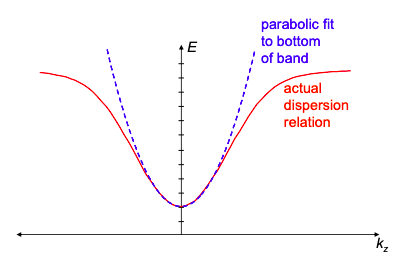4.12: Effective Mass
- Page ID
- 51316
So far, both the classical and quantum models of conduction have assumed that the current carrying electrons occupy pure planewave states. The dispersion relation of real materials, however, varies from the ideal parabola. We can approximate any dispersion relation by a plane wave if we allow the mass of the electron to vary. We call the modified mass the effective mass. Under this approximation, the electron is thought of as a classical particle and various complex phenomena are wrapped up in the effective mass. For example, given dispersion relation E(k), a Taylor expansion about k = 0 yields:
\[ \left. E(k) = E(0)+k\frac{dE}{dk} \right|_{k=0} \left. + \frac{1}{2}k^{2}\frac{d^{2}E}{dk^{2}} \right|_{k=0} + … \nonumber \]
Approximating the dispersion relation by a plane wave gives
\[ E(k) = E_{0} + \frac{\hbar^{2}k^{2}}{2m^{*}} \nonumber \]
Equating the quadratic terms in Eqations. (4.13.1) and (4.13.2) we get an expression for the effective mass
\[ m^{*} = \hbar^{2}\left( \frac{d^{2}E}{dk^{2}} \right)^{-1} \nonumber \]
The effective mass concept is commonly used in classical models of electron transport, especially models of mobility like Equation (4.12.2).



